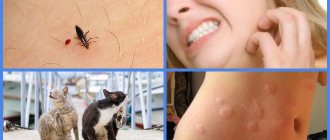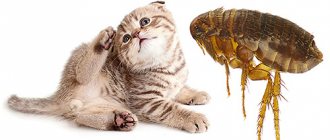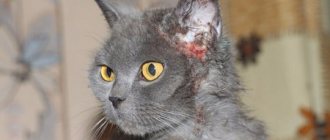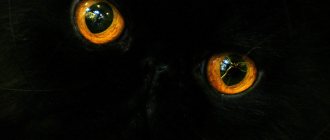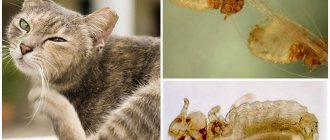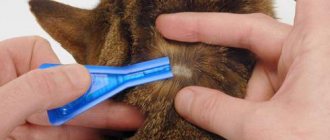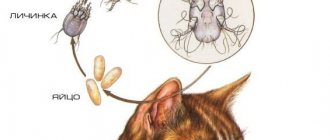Cat and dog fleas
Cat fleas (Ctenocephalides felis) are biologically different from dog fleas (Ctenocephalides canis), but these differences can only be visualized using a microscope.
Despite their name, cat fleas bite dogs and many other animals, as well as people. In the United States, the predominant share of infection comes from cat fleas, and in Europe – from dog fleas. In the photo, the dog flea is on the left, and the cat flea is on the right.
Varieties
Three types of fleas can infest cats:
- Feline. The most common blood-sucking insect, parasitic, including dogs and rodents. Cat fleas do not disdain human blood, although humans cannot be their carrier due to the lack of fur. Important features of these parasites : Body length - from 0.5 to 3 mm, however, in females bearing eggs, the body can stretch up to 16 mm;
- They have a durable shell, which makes them quite difficult to destroy mechanically;
- Dark brown body color. On a white sheet, a flea looks like a black dot;
- Attachment to one owner - a new carrier is sought only after his death;
- The eggs are very small (up to 0.5 mm), so it is very difficult to detect them, especially in the fur of an animal;
- Development cycle - 50 days;
- Canine. They are very similar to cats in size, structure and diet, but have a number of differences : Larger body - from 0.75 mm to 5 mm in length;
- A less durable shell, although it will take a lot of effort to crush it;
- The development cycle is shorter - only 25 days;
- Differences in structure: elongated proboscis, rounded forehead, extended genital claw.
- Body up to 4 mm long;
Video about fleas in pets:
How fleas bite
Cat fleas are obligate parasites. Both male and female individuals live solely off the blood of the host. This type of feeding is also characteristic of some types of flies. In other parasitic insects, only the female is involved in blood sucking. Fleas are also among the rare insects that require blood throughout all stages of their life cycle. This also applies to larvae, which consume feces of adult fleas, saturated with blood.
Non-motile ectoparasites
Fleas live on the surface of the host's body, rather than inside it, and are therefore classified as ectoparasites (parasitic externally). When sucking blood, parts of the oral apparatus are embedded under the skin of the host, while the body and other parts of the insect's body remain motionless, so fleas are considered sessile ectoparasites. Fleas do not attach to hosts like ticks. Their body is covered with spines, bristles and ridges that prevent the insect from removing the insect from the host's hair.
Fleas on a domestic cat: description
Fleas are the largest order of blood-sucking insects that have complete metamorphosis. A flea that has drunk blood lays several dozen eggs within a radius of 1-2 meters from its host, including on his body. After a couple of weeks, the eggs hatch into worm-like larvae that feed on excrement and organic debris. Soon they acquire three pairs of limbs (including hind hocks) and develop into a full-fledged adult.
REFERENCE : Fleas do not have wings, but they jump well. The length of the flea's jump reaches 50 cm, and the height is 30 cm.
Specifics of the structure of these insects:
- An oblong, laterally flattened body several millimeters long;
- A piercing-sucking apparatus adapted for cutting through the skin to the capillaries;
- In the back of the body there are unique hairs that capture air movements, thanks to which the flea is perfectly oriented in space.
The flea has excellent endurance. At a temperature of +7+14*C, it can remain without food for up to 12 months, waiting for its carrier. At lower temperatures it goes into suspended animation. In apartment conditions (20-25*C), the parasite cannot live longer than two months, and when the thermometer rises above 30*C, the flea's life period is reduced to 1 month.
How do fleas feed?
Exploratory samples
Once on the host's body, fleas first look for a suitable place to bite using their palps. The skin is then punctured and the search for the blood vessel begins. The flea injects saliva into the wound with anti-clotting properties, which helps in the search for blood.
A test piercing causes an allergic reaction on the skin, which is why flea bites are often observed in clusters of 3-4 pieces. The abdomen consists of 4 salivary glands, which are connected to the oral cavity. In addition to the anticoagulant, saliva contains a substance that facilitates the penetration of the proboscis into the skin.
Distractions during blood sucking
Fleas are often distracted while sucking blood, this is due to the movement of cats or dogs. Once interrupted, the parasites move and bite nearby, resulting in several bite marks appearing on one area of skin.
Duration of blood sucking
Cat fleas begin sucking blood within 5-20 minutes after attacking the owner. They become saturated within the first 10 minutes. On average, females suck blood for 25 minutes, and males for 11 minutes. Females suck twice as much blood as males.
Digestion
Blood that enters the digestive tract does not flow back into the vessel thanks to the valve, which ensures one-way movement of blood flow, preventing regurgitation. The digestive tract releases components necessary for digestion. The digestive enzymes of fleas are adapted to digest blood.
It is believed that there are gender differences in the digestion process, as female fleas digest blood faster than male fleas. It is important for females to digest blood quickly as they need nutrition and energy to lay eggs.
Adult parasites suck much more blood than they can digest. Because blood passes quickly through the intestines, it is only absorbed by nearby cells in the intestines. As a result, fleas excrete large amounts of feces, consisting mainly of undigested blood. These feces serve as the main source of food for the larvae.
How do fleas get into our home?
In 90% of cases, parasites come to an apartment on pets. They rarely jump off their owner and do not touch the people around them. However, when fleas reproduce, they lay their eggs on bedding, under cabinets, in floor crevices and in other hard-to-reach places.
Under suitable conditions, within a month the eggs will turn into full-fledged bloodsuckers looking for their prey.
Therefore, the fight against fleas must begin before they reproduce.
However, there are cases when these insects are found in homes where neither a dog nor a cat has ever been. The presence of parasites may be due to the following factors :
- Entering with mice or rats that have access to the living space or have dug holes nearby;
- Migration of fleas from neighboring rooms (for example, after baiting or death of the owner) through ventilation ducts or staircases;
- Entering the premises together with outer clothing after visiting the basement or attic;
- Delivery of parasites along with furniture that has been standing for a long time on the street, in a barn or in a garage.
The role of blood in the life cycle of fleas
Fleas feed on blood throughout their entire life cycle. Even larvae need fecal digested blood. Adult insects - females and males - suck the host's blood. Blood is not just food for fleas; without it, mating and reproduction are impossible. Young individuals without blood do not reach sexual maturity: the ovaries of females and the testicles of males remain underdeveloped.
Hungry adults are not capable of mating. Blood sucking stimulates sexual development and further reproduction. Adult insects consume much more blood than they can digest. Blood passes quickly through the intestines, and only part of it is absorbed. As a result, the adults excrete copious amounts of feces in the form of undigested blood.
The larvae live off this feces. In this way, adult insects take care of their offspring. This is believed to be the first step on the evolutionary ladder for fleas to care for the next generation.
Do fleas bite through clothes?
As a rule, they do not bite through clothing. Jeans, socks and even thin fabrics will prevent bites. However, there are a few exceptions. Fleas can bite through thin, tight fabric, such as tights, sweatpants, or yoga pants.
Fleas bite under clothes
Not finding direct access to the skin, they will crawl under clothing and bite there. These parasites prefer to feed in hidden places and suck blood while remaining unnoticed. If disturbed while bloodsucking, they hide in the seams of clothing for up to 24 hours and periodically come out to bite again.
Why Clothing Protects Fleas
According to some experts, although clothing serves as protection against bites, it actually helps parasites. It is easier for a flea to attach to the fabric fibers of clothing than to the bare skin of a person. Once on the human body, bloodsuckers will find a place with an area of skin open to a bite or crawl under clothing to do this. Clothing is a kind of camouflage for them, under which they freely suck blood.
What areas of the body do fleas bite on?
Cat fleas jump an average of 15 cm in height (maximum 20 cm). This height corresponds to just below the human knee. Once on a person, they bite in the place they hit, without significant movement. As a result, bites are usually found on the legs, feet and ankles.
In rare cases, bite sites appear higher; for example, if a person is sitting on the floor, then fleas easily end up in unusual places: in the pelvis, groin, and wrists. Bites on the face are unlikely, except in children.
The best clothes against flea bites in the apartment and on the street
Clothing that does not leave exposed skin is best at preventing bites. Wearing socks and long pants will protect against leg bites. However, there is still access to exposed skin between the socks and trousers; this can be solved by tucking the trousers into the socks.
Repellents for clothing
To stop fleas from attacking clothing, repellents such as permethrin are used. Permethrin is an insecticide, but in low concentrations it acts as a broad-spectrum insect repellent. Permethrin repels fleas, mosquitoes, ticks and biting flies. It binds tightly to the fibers of clothing, so it is resistant to water, washing and drying. Treated clothing repels insects for up to 6 weeks or 6 washes.
How to get rid of fleas in an apartment
It is impossible to kill all fleas on an animal's body. There will still be a few parasites hiding in your apartment. To prevent them from attacking your pet again, it is necessary to thoroughly disinfect the room.
The best way to remove fleas from your apartment is to get rid of pest control specialists. The most effective is the use of a heat gun, which quickly destroys parasites and their eggs. Of course, for this it is better to vacate the apartment for a few days.
You can carry out disinfestation yourself. For these purposes, a special powder is used. True, the active components of the product are toxic, so be sure to:
- Evict everyone from the apartment for the next few days. People and pets must leave the premises.
- Take out the houseplants.
- Buy a protective mask for your face and respiratory tract.
After this, apply the product to all surfaces. No exceptions - treat not only walls and floors, but also bedding, clothes, carpeting, etc. Close all windows and leave the room for 12-18 hours. After this, you should thoroughly ventilate the rooms and thoroughly wash and rinse all items on which the product was applied.
What do cat flea bites look like?
Flea bites vary in intensity depending on the human body and the degree of sensitization. Sensitization is an increase in the body's sensitivity to irritants, causing allergies. As a rule, the reaction to insect bites occurs in 5 stages of sensitization, which correspond to the frequency of previous bites.
5 stages of sensitization
- In the absence of previous contacts with parasites, sensitization does not occur. In this case, there will be no reaction to the bite.
- Subsequent stings cause a delayed or late reaction after 24 hours.
- As the frequency of bites increases, both immediate and late reactions occur.
- Continued flea bites on human skin reduce the intensity of the late reaction. After all, only immediate reactions appear.
- Over time, with an increase in the frequency of bites, complete desensitization is achieved in the human body - immunity to insect bites appears.
Young children have a low level of sensitization, and, as a result, flea bites in children cause more pronounced delayed reactions than in adults. Achieving complete immunity in adults and children is rare, since the second stage lasts at least 1.5 years.
Immediate reactions
Hives
Within 5-30 minutes, bites on the body cause hives. Hives are areas that rise above the surface of the skin, framed by a halo of redness. Redness of the skin occurs due to dilation of superficial blood vessels. The areas of urticaria have an irregular shape, but clearly defined boundaries. The diameter of the urticaria areas is 2-10 mm. The urticaria quickly disappears without any significant symptoms of irritation.
Bite marks
Fleas are adapted to pierce the skin without leaving damage. There is little or no bleeding at the bite site. Bites on the human body do not leave marks unless the insect gets into the vessel. Bite marks, represented by red dots called hemorrhagic marks, disappear within 3-4 days.
Delayed skin reactions
Papules
If a person is bitten by fleas, then delayed reactions develop 12-24 hours after the bite. Such reactions include, for example, papules. A papule or nodule is a cavity-free formation that rises above the skin level. Papules are accompanied by areas of skin redness around the formation. The diameter of the papule is 1-3 mm, and the redness reaches 20 mm. In rare cases, a vesicle or bubble forms inside the papule. Also, in the middle of the papule, the color of the skin sometimes turns black, indicating necrosis - the death of the skin area. Papules disappear on the third day, but in rare cases they persist for up to a year.
Flea bites often appear in clusters of three bites up to 3-4 centimeters in diameter. The bites are arranged in a line or triangle. This cluster is humorously called “breakfast, lunch and dinner.”
Bubbles (vesicles)
Flea bites rarely cause blisters on the skin. However, in atypical cases, delayed reactions appear in the form of a vesicle. Initially, the fluid accumulates under the skin in multiple vesicles, and after 2-3 days the vesicles grow and unite into a large vesicle called a bulla. The skin around the vesicle turns red. As healing progresses, the skin darkens and the vesicles disappear.
Secondary infections
Flea bites are sometimes very itchy and, as a result, make you want to scratch. Scratching damages the skin and creates conditions for bacteria to enter, which often happens. Infected bite sites are filled with pus, and phlycterns are formed.
Flycterna is a bubble surrounded by an area of reddened skin, inside of which there is serous or purulent discharge. When there is extensive damage to the skin, abscesses occur.
Why are fleas dangerous for your cat?
A flea bite can be dangerous both in itself and if the insect is a carrier of more serious diseases.
In the first case, parasite bites cause severe discomfort in the animal. Fluffies may experience an allergic reaction. And the wounds themselves constantly hurt and itch, forcing the animal to tear them with its claws until they bleed.
Meanwhile, any open wound is a risk of infection. Purrs with weakened immune systems are especially susceptible to this. A flea can not only damage the skin, opening up a place for infections to enter. This parasite is often an intermediate host for helminths – that is, it transports worm eggs into the cat’s body.
Fleas multiply at maximum speed, so don't think that your four-legged friend will get by with 1-2 bites. Over time, this can lead to bald patches appearing on the cat’s body, and in general the coat will lose its healthy and shiny appearance.
Large flea colonies require large amounts of blood. Therefore, they are especially dangerous for small pets - frequent bites can cause anemia.
Pain after flea bites
Flea bites are not painful. In fact, people often don't notice they are being bitten until they see the fleas. As a rule, bites are recognized after a reaction appears on the skin, which may not appear at all, which is why it seems that fleas bite some and not others.
When they bite, they inject saliva into the surrounding skin. Saliva prevents blood from clotting, spreads, and softens the layers of skin. This helps the needle-shaped mouthparts penetrate the skin easily. After bloodsucking, there are almost no traces of damage left on the host’s skin.
How to distinguish flea bites from bedbug and mosquito bites on humans
In this article, we looked in detail at what flea bites look like. But even with this knowledge, it is difficult to immediately recognize their bites, which are confused with the bites of mosquitoes and bedbugs. The symptoms of a flea bite in humans are indeed very similar to the symptoms of other bites - hives, itching and swelling occur. To learn how to distinguish, below is a table of the differences between flea, bedbug and mosquito bites.
| Symptom | Insect | ||
| Bedbugs | Fleas | Mosquitoes | |
| Bite marks | Small, deep bites with a hole in the middle and an area of redness around it. Blisters may appear around the puncture | Bite marks are medium-sized, hard, red dots. | Small red dots |
| Where do they bite? | Clusters of 3-5 bites form marks on any part of the body | As a rule, 2-3 bites form a mark. The tracks are called breakfast, lunch and dinner tracks. Most often they bite the legs and legs, less often the upper parts of the body | Single bites, dots appear all over the body |
| Appearance time | Bedbugs are nocturnal insects, so bites occur in the morning | Bites appear at any time | Bites appear at any time |
| Itching | Obsessive itching disappears within 1-24 hours | Goes away within 2-3 hours, does not always appear | Intense itching disappears within a day |
| Other typical symptoms | Brown stains on sheets and mattresses appear as a result of accidental crushing of bedbugs during sleep | Sometimes there is severe pain at the time of the bite. It is rare to spot an insect | The flight of a mosquito can be heard, and besides, after a bite, the skin is very itchy |
| Peak insect activity | Insects are active all year round | According to the Canadian Department of Environment, high activity occurs towards the end of summer. | Activity increases in summer and autumn |
The difference between an earthen flea and a cat flea
The external picture will not be much different, but the cat’s fleas are larger than their counterparts. The color of the earthen pest is bright black; it nests in the soil, dry foliage, and under stones. They are also inhabitants of wet, unkempt basements. Residents of the first floors and private houses suffer from infestations of such fleas.
A dog was bitten by a tick: what it looks like, signs and what to do
For your information! The Brazilian penetrating flea penetrates the skin of animals and people, settles under the nails, bites into the epidermis, and provokes inflammation. This subspecies exists in the countries of Southern and Northern Africa.
